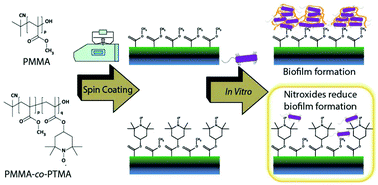Polynitroxide copolymers to reduce biofilm fouling on surfaces†
Abstract
Biofilms are highly organised colonies of microorganisms, at a surface or an interface, which are extremely resistant to treatment with biocides or antimicrobials. Consequently, biofilms are the primary cause of fouling and persistent infections in both industrial and clinical settings. Thus, there is a clear need to develop coatings that are able to prevent the growth of biofilms on surfaces. Herein, we report the development of polynitroxides for use as anti-biofilm coatings. We demonstrate that we can tune the composition of the nitroxide 2,2,6,6-tetramethyl-4-piperidyl methacrylate in a copolymer with methyl methacrylate in order to control the surface concentration of nitroxides in the resulting thin films. The prepared films are able to reduce biofilm fouling by Pseudomonas aeruginosa (PAO1) at nitroxide monomer concentrations as low as 30 wt%. The nitroxide containing materials show no difference in toxicity to mammalian cells, compared to poly(methyl methacrylate), in a proliferation assay with 3T3 fibroblast cells. This is the first demonstration of surface tethered nitroxides with activity against biofilms and provides new opportunities for developing antifouling surface coatings.



 Please wait while we load your content...
Please wait while we load your content...